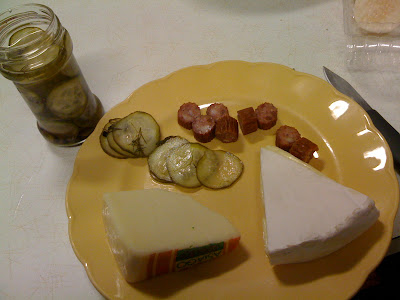As a keen gardener, but also a reasonably time poor (and often cash poor) gardener I believe that seedlings have a valid place in a backyard garden, and here are a couple of reasons why:
- A punnet of seedlings often costs the same as a packet of seeds. If you're anything like me, you don't want an entire packet's worth of spotted Turkish gourds, so it makes sense to just buy a ready sprouted punnet, particularly if you know that you can save the seeds for a following year (if the spotted gourds are worth it). If you're fortunate enough to have a local seedling producer such as Hobart Kitchen Gardens, who sells individual pumpkin seedlings for $1 each, which have been grown from seeds produced by the Tasmanian-based Lost Seed company (they specialise in heirloom, true-to-type seeds, which means that you can reliably save seeds), then you'll actually be saving money with the knowledge that you can grow them again next year with the saved seeds. A couple of months ago, I bought 3 pumpkins from the HKG stall at the Melville St Farmer's Market. All three were of different varieties and cost me $3 overall. If I'd bought seeds, it would've cost me almost $10 for the 3 packets. Yes, I would've had about 25 seeds in each packet, vs the one pumpkin seedling, but considering that I have a number of butternuts that I've grown from seed already (last year's saved seeds), who has room for that many pumpkins in a suburban backyard?
- Scenario 1: you've planted a packet of basil, and watched as the seeds sprouted, the little seedlings growing under your loving care as the spring weather warms the ground. You're dreaming of all the pesto you're going to make etc etc.... and then one night, when they're about 3 cm tall, the entire patch is decimated by snails, an evil army of snails. True story. In this case, my solution was to buy another packet of seeds, but also buy a punnet of basil, so that I'd have some already started at the same growth as my homegrown seedlings. When the beasts attack, seedlings are great consolation presents...
- Scenario 2: you've dug up a patch of weeds, and want to fill it quickly and cheaply with some colour. So you go buy those tubs of pansies that are always for sale at 5 for $5 or something like that. The pansies not only fill a gap, but are great for blocking weeds from coming up, particularly as they spread quite rapidly. (plus, this is kinda embarrassing, but I cannot, for some perverse reason, grow pansies from seed. If anyone has any tips, please share)
- You're new to gardening, you want to start off nice and easy, and it's a lot quicker and easier to buy seedlings than seeds, particularly as a lot of seeds need special conditions to sprout. Don't feel guilty about buying seedlings, there's no shame.
Rant over.
Incidently, I've been growing some things by seed in pots before I transfer them into the ground. I've had little or no limited luck growing things like lebanese cucumbers, sunflowers, snapdragons, and pansies from seed in the ground, so it's often better to grow them in punnets and then transfer them to the ground later (something that I've only just acknowledged). Some of the punnets, such as the Tigerella tomatoes and many butternut pumpkins have been given away as Christmas presents.
Pictured below are my 'flower' seeds: Sunflowers in the foreground, Zinnias on the right middle, black pansies and snapdragons in the unchanged pots (of course):
 |
| At one week |
 |
| After 2 weeks. Note the still empty Pansy punnets... Oh and 'Nola' -the grape - is in the front |
 |
| One week in (note the number of black ex-pansy pots) |
 |
| Two weeks later (with a couple of presents for friends missing) |











.JPG)
.JPG)
.JPG)
.JPG)

































